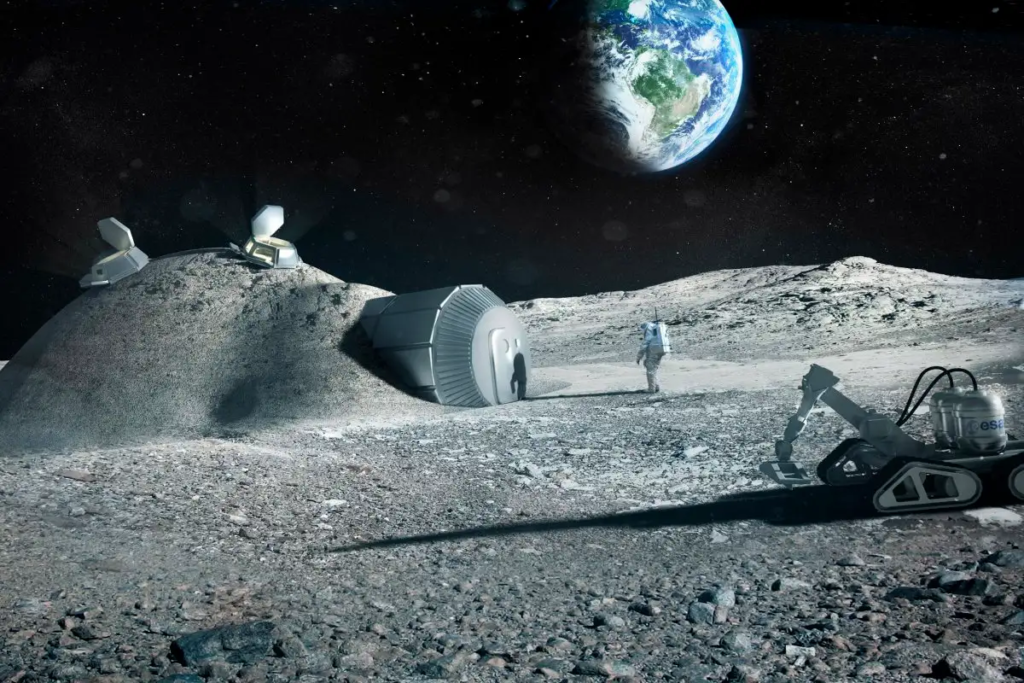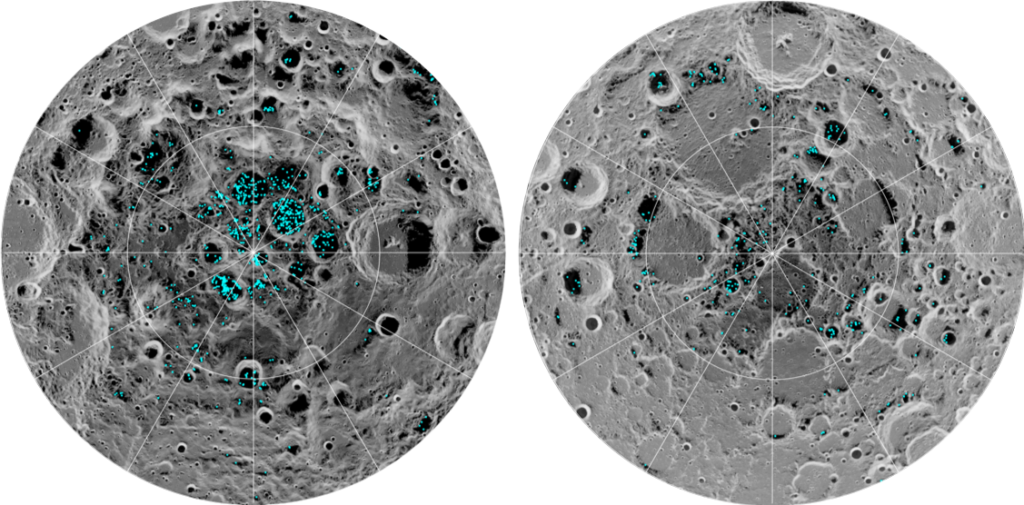
NASA’s Current Plans For A Moon Base
It has been over half a century since astronauts made history and stepped foot on the Moon. With Artemis I complete, the complex process of returning humans to this celestial body is making progress. So much so that this ambitious idea and goal is starting to become a lot more realistic. However, it brings up the question of when will these exciting missions happen, and how will the agency support extended missions on the surface.
The goal of Artemis is to not only return humans to the Moon, but setup a more permanent human presence. In order for this to be successful, an immense amount of infrastructure is needed to safely and efficiently keep humans in good condition. Not to mention the fact that the landing site has already been picked and is set to be on the Moon’s south polar region.
An area ripe for scientific investigations but harsh with low light levels, and low temperatures, just to name a few. In terms of innovation, the agency has invested significant funding in developing the ability to extract oxygen from lunar regolith and water from lunar ice. Just one of many exciting possible solutions to a host of challenges of living on the Moon. Here I will go more in-depth into NASA’s current Moon base plans, when we should expect to see this happen, why it’s so important, and more.
Moon Base Plan

Based on current progress, Artemis II is set to happen in 2024. Here astronauts will board Orion and fly around the Moon before returning to Earth. If successful, in either 2025 or 2026, NASA will send humans again but this time to land on the surface. From here, the agency will begin making more frequent missions, creating Moon space stations, and more, as the lunar base starts to take shape.
On the surface, for the first few missions, the human landing system will double as lunar lodging, offering life support systems to support a short crew stay on the Moon. In the future, however, NASA envisions a fixed habitat at the Artemis Base Camp that can house up to four astronauts for a month-long stay. Since 2016, NASA has worked with several companies on their habitation systems and designs, assessing internal layouts, environmental control and life support systems, and outer structure options, including rigid shells, expandable designs, and hybrid concepts.
Just over one month ago NASA awarded ICON a $57.2 million contract to develop construction technologies that could help build infrastructure such as landing pads, habitats, and roads on the lunar surface. This company specializes in 3D printing large structures. For example, ICON 3D printed a 1,700-square-foot simulated Martian habitat, called Mars Dune Alpha, that will be used during NASA’s Crew Health and Performance analog mission starting in 2023. The company also competed in NASA’s 3D Printed Habitat Challenge. Here the company won an award for 3D printing a structure sample that was tested for its ability to hold a seal, for strength, and for durability in temperature extremes. For future Moon applications, these structures will need to be easy to build, help with radiation, temperature, and more.
In addition to future habitation, some of the core resources that create the biggest challenge for a sustained lunar presence include water, oxygen, and food. Earlier this month on the 9th NASA released a report regarding a lunar south pole oxygen pipeline. It’s important to point out that the sustainability of the Artemis program and its goal of developing a permanent human presence on the Moon is dependent on the ability to utilize Moon resources to reduce the cost and risk of lunar operations. NASA and the US government have invested significant funding in developing the ability to extract oxygen from lunar regolith and water from lunar ice. The oxygen will be used for: 1) human habitats, rovers, other life support systems with a constant supply of high purity oxygen for human consumption; 2) oxidizer for launch vehicles departing the Moon. These oxygen extraction technologies are planned to be demonstrated at a large scale on the Moon as early as 2024 and provide direct support to Artemis astronauts as early as 2026.
The starting concept is for a 5 km pipeline to transport oxygen gas from an oxygen production source to an oxygen storage/liquification plant near a lunar base. The pipeline is composed of in-situ manufactured pipe segments that are welded or fitted together to span the 5 km distance. In this case, they plan to use aluminum found on the planet for this pipe. The pipeline is designed to have an oxygen flow rate of ~2 kg/hour which is commensurate with the NASA initial projected need of 10,000 kg/year, operate with minimal power over the lifetime of the pipeline, and have a high operational reliability and be able to survive in the lunar environment for > 10 years.
Lunar South Pole

For years now, NASA has known that the lunar south pole would be the location of these future missions. In comparison, the Apollo missions landed in the central part of the northern hemisphere. While a bit more tricky, the agency is confident that the lunar south pole offers very unique science opportunities. Even though the South Pole region has many well-illuminated areas, some parts see more or less light than others. Scientists have found that at some higher elevations, such as on crater rims, astronauts would see longer periods of light. But the bottoms of some deep craters are shrouded in near constant darkness, since sunlight at the South Pole strikes at such a low angle it only brushes their rims.
A base camp site will require lots of light, however, it’s also important for astronauts to be able to take short trips into permanently dark craters. Scientists expect that these shadowed craters are home to reservoirs of frozen water that explorers could use for life support. “One idea is to set up camp in an illuminated zone and traverse into these craters, which are exceptionally cold,” said a NASA Goddard planetary scientist who’s involved with NASA’s South Pole site analysis and planning team. Temperatures in some of the coldest craters can dip to about -391 degrees Fahrenheit (-235 degrees Celsius).
The landing area, ideally, should be separated from other base camp features — such as the habitat or solar panels — by at least half a mile, or 1 kilometer. It also ought to be situated at a different elevation to prevent descending spacecraft from spraying high-speed debris at equipment or areas of scientific interest. Some scientists have estimated that as a spacecraft thrusts its engines for a soft landing, it could potentially spray nearly a million pounds, or hundreds of thousands of kilograms, of surface particles, water, and other gases across the surface. Something NASA wants to make sure they avoid in the future.
Since the south polar region offers so many scientific opportunities, astronauts will need a mode of transportation to get around faster and provide additional capabilities. NASA has proposed two lunar surface transportation systems: a lunar terrain vehicle (LTV) and a mobile home and office referred to as a habitable mobility platform. The LTV will be an unpressurized, or open-top vehicle, that astronauts can drive in their spacesuits for more than 12 miles from a camp site. In addition to the LTV, a pressurized rover will greatly expand lunar surface exploration capabilities to the next level. Pressurization means that astronauts can be in the vehicle in their regular clothing as opposed to wearing their spacesuit inside too. This will provide more comfort to work as they cross the lunar terrain in their mobile habitat and explore large areas. When they’re ready to go outside to collect samples or set up experiments, they would need to put their spacesuits on again. A lot of which depends on the exact landing site and what’s around it.
The Sun hovers over the lunar South Pole horizon continuously throughout the day and year, providing a near-constant source of energy for solar power opportunities. There is no single location, however, that avoids periods of darkness. This means NASA must plan for early Artemis systems to survive the extremely cold environment without power, to build in the capability to store power for up to eight days. For longer-term work trips to the Artemis Base Camp, NASA’s Lunar Surface Innovation Initiative is working with the U.S. Departments of Energy and Defense to develop a nuclear fission surface power unit that can continuously provide 10 kW of power – the average annual power consumption of a home here on Earth. This small power plant will be able to power and recharge the other basic elements of the Artemis Base Camp and allow greater flexibility for mission planning by easing the requirement for continuous access to sunlight in a distinct location during a specific timeframe.
“On each new trip, astronauts are going to have an increasing level of comfort with the capabilities to explore and study more of the Moon than ever before,” said the associate administrator for human spaceflight at NASA Headquarters in Washington. “With more demand for access to the Moon, we are developing the technologies to achieve an unprecedented human and robotic presence 240,000 miles from home. Our experience on the Moon this decade will prepare us for an even greater adventure in the universe – human exploration of Mars.”
Conclusion
While by now means easy, NASA is working with many different companies and other agencies to figure out how we can live on the Moon. Recently, the agency signed a contract with a company that focuses on 3D printing lunar and martian structures. This comes in addition to funding related to a 5 kilometer lunar pipeline. We will have to wait and see how it progresses and the impact on the space industry.

Great intro, consider adding artist concepts’, drawings. What is the names of the people and/or office. developing possible base locations and developing nuclear powered robotic research rovers, based on Mars rover design.